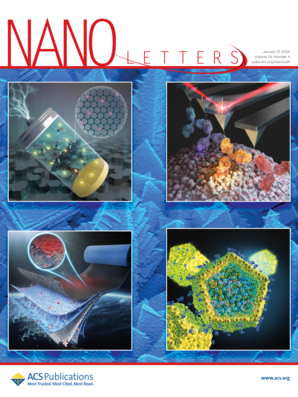Sustainable Protein to Generate High-Strength and Durable All-Underwater Adhesive via Physical Condensation Boosting Chemical Cross-linking
IF 9.6
1区 材料科学
Q1 CHEMISTRY, MULTIDISCIPLINARY
引用次数: 0
Abstract
Designing high-performance protein adhesives for hard tissue applications remains challenging. Here, we present a physical condensation boosting chemical cross-linking strategy to produce a high-performance all-underwater adhesive composed of corn-derived zein, genipin, and poly(l-lysine). Physical condensation between anionic zein colloids and cationic poly(l-lysine) generates a soft adhesive. Dehydration of the ionic moieties enables powdery genipin to be pre-encapsulated into the dried bulk of the physical condensate. After experiencing reversible hydration, the genipin-encapsulated adhesive can be injected and bonded to various surfaces under the waterline. Crucially, the condensed adhesive creates confined microenvironments for genipin-bridged slow chemical cross-linking, achieving sequential adhesion and curing, and in situ self-reinforcement. The protein adhesive exhibits an adhesion strength of 2.0 MPa on bovine bone and excellent friction resistance (μ ∼ 0.15). Moreover, the adhesive shows long-term stability in various complex aqueous environments. These properties coupled with excellent biocompatibility, sustainability, and scalable production indicate significant potential in bone adhesion and device coatings.

可持续蛋白质通过物理凝结促进化学交联产生高强度和耐用的全水下粘合剂
设计用于硬组织应用的高性能蛋白质粘合剂仍然具有挑战性。在这里,我们提出了一种物理缩合促进化学交联的策略,以生产一种高性能的全水下粘合剂,该粘合剂由玉米衍生的玉米蛋白、皂角素和聚赖氨酸组成。阴离子玉米蛋白胶体和阳离子聚赖氨酸之间的物理缩合产生一种柔软的粘合剂。离子部分的脱水使粉状皂荚素能够被预先封装到干燥的物理凝聚体中。经过可逆的水化作用后,可以注入并粘合到水线以下的各种表面。最重要的是,凝聚的粘合剂为genipin桥接的缓慢化学交联创造了有限的微环境,实现了连续的粘合和固化,并在原位自我增强。该蛋白黏合剂在牛骨上的黏附强度为2.0 MPa,具有良好的摩擦阻力(μ ~ 0.15)。此外,该胶粘剂在各种复杂的水环境中表现出长期的稳定性。这些特性加上优异的生物相容性,可持续性和可扩展的生产表明骨粘附和设备涂层的巨大潜力。
本文章由计算机程序翻译,如有差异,请以英文原文为准。
求助全文
约1分钟内获得全文
求助全文
来源期刊

Nano Letters
工程技术-材料科学:综合
CiteScore
16.80
自引率
2.80%
发文量
1182
审稿时长
1.4 months
期刊介绍:
Nano Letters serves as a dynamic platform for promptly disseminating original results in fundamental, applied, and emerging research across all facets of nanoscience and nanotechnology. A pivotal criterion for inclusion within Nano Letters is the convergence of at least two different areas or disciplines, ensuring a rich interdisciplinary scope. The journal is dedicated to fostering exploration in diverse areas, including:
- Experimental and theoretical findings on physical, chemical, and biological phenomena at the nanoscale
- Synthesis, characterization, and processing of organic, inorganic, polymer, and hybrid nanomaterials through physical, chemical, and biological methodologies
- Modeling and simulation of synthetic, assembly, and interaction processes
- Realization of integrated nanostructures and nano-engineered devices exhibiting advanced performance
- Applications of nanoscale materials in living and environmental systems
Nano Letters is committed to advancing and showcasing groundbreaking research that intersects various domains, fostering innovation and collaboration in the ever-evolving field of nanoscience and nanotechnology.
 求助内容:
求助内容: 应助结果提醒方式:
应助结果提醒方式:


